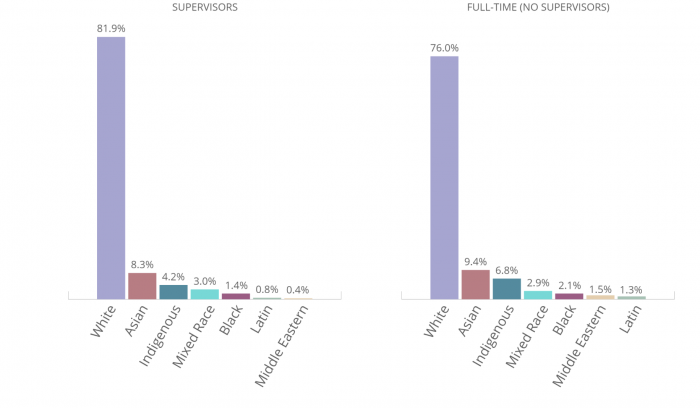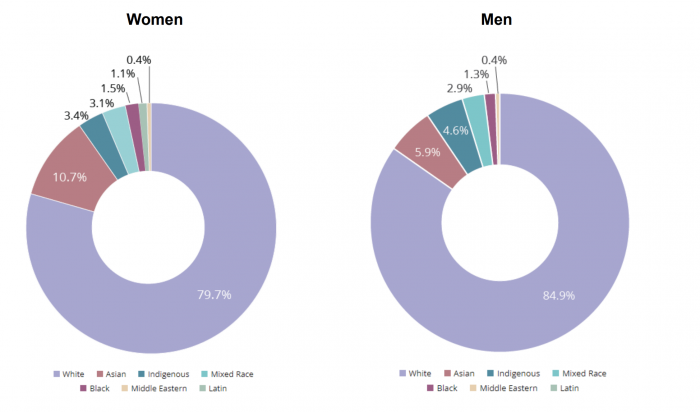
Almost half of all newsrooms in Canada have only white people on staff, and nearly 80% of all newsrooms don’t have any Black or Indigenous journalists on staff. These are among the top findings of the inaugural diversity survey from the Canadian Association of Journalists.
The survey was conducted between November 2020 and July 2021, and includes data from 209 outlets (surveys were sent to nearly 640 outlets, but only a third provided complete responses).
Here are some of the other key findings:
- In total, the survey collected data on 3,873 journalists working in 209 newsrooms.
- 52.7% of all newsroom staff identify as women compared to 46.7% who identify as men and 0.7% who identify as non-binary.
- Of the journalists where race data is known, 74.9% identify as white compared to 18.6% who identify as a visible minority, and 6.4% who identify as Indigenous.
- About nine in 10 newsrooms have no Latin, Middle Eastern, or mixed race journalists on staff.
- About eight in 10 newsrooms have no Black or Indigenous journalists on staff.
- 81.9% of supervisors identify as white, compared to 1.4% who identify as Black, 8.3% who identify as Asian, and 4.2% who identify as Indigenous.
- 79.6% of outlets report having no visible minorities or Indigenous journalists in one of the top three leadership roles in their newsroom.
- Black and Middle Eastern journalists are twice as likely to work part-time jobs as full-time jobs.
- 27% of all interns identify as Asian, compared to 9.1 per cent of full-time journalists.
- The racial identity of 25% of journalists included in this survey is unknown by their newsroom managers.
These findings are not too surprising, nor do they differ greatly from what similar surveys of American newsrooms have found. The News Leaders Association and American Society of News Editors, which have tracked diversity in newsrooms in some form, found in its most recent survey in 2019 that journalists of color made up around 22% of salaried staff in the newsrooms that responded to that year’s survey (that figure was nearly 33% for people at online-only publications).
Though the ASNE/NLA survey has a long history of tracking diversity, the survey has faced roadblocks in the past two years. Meredith Clark, the researcher in charge of the survey in recent years shared on Twitter that the organizations would be “pausing on data collection this year to fully revise our approach.” Two months ago, Clark told the Associated Press that the survey deadline had to be extended because of a poor response rate from newsrooms seemingly unwilling to share their diversity data.
It’s unclear what hurdles the CAJ survey will face, even as the researchers behind the survey write that they have plans to increase both the number of newsrooms and the number of journalists who participate in next year’s survey.Beyond overall demographics, the CAJ survey also broke down some of the nature of the work being done by journalists who don’t identify as white, and found that these journalists were less likely than their white colleagues to be in full-time jobs. For instance, although 84% of white journalists included in the survey were full-time workers, that figure among Black journalists was around 64%, and it was 60% for Middle Eastern journalists. Roughly 75% of Asian journalists work full-time, while 80% of Indigenous journalists are employed full-time.
Differences also emerge when it comes to seniority. While women slightly outnumber men when it comes to leadership positions (52% to 47%), racial disparities are more stark. More than 80% of supervisory roles are held by a white journalist, compared to about 1% held by Black journalists, Middle Eastern journalists and Latin journalists each.

At the same time, women journalists from communities of color hold 20% of supervisor roles compared to 15% of male journalists of color who do the same. The trend was similar for top roles in newsrooms:
Of the newsrooms that indicated they had a visible minority or Indigenous journalist in at least one of their top three newsroom roles, 57.9% are held by women compared to 42.1% held by men. There are no non-binary Indigenous or visible minority journalists in a top leadership role. Around 8 in 10 outlets reported having no visible minority or Indigenous journalists in one of the top three leadership roles in their newsroom.

The survey also found that supervisors who were asked to fill out the questionnaire are more optimistic of their newsroom’s representation than the reality reflects. Among this group, 70% said that their newsroom is somewhat or very representative of their audience. But when compared to the actual census, less than a third of all participating newsrooms were found to be as diverse or more diverse than the public they serve.
For example, survey results for Metroland Toronto were compared against census data for the City of Toronto showing that 93.3 percent of all staff at that outlet identify as white, compared to 48.3 per cent of Torontonians identifying as such. Similarly, results for the Canadian Press newsroom were compared against national census results showing 87.3 per cent of staff identify as white compared to 73.2 per cent of Canadians nationally.
The upshot? Although Canadian newsrooms are overwhelmingly white and not necessarily representative of the audiences they serve, those newsrooms with leaders from traditionally underrepresented backgrounds tended to have more diverse workforces. Many newsrooms included in the CAJ survey also said that although this was the first year they collected data on race, gender and other demographics among their staff, they plan to keep up with the practice every year.
Read the full report here.